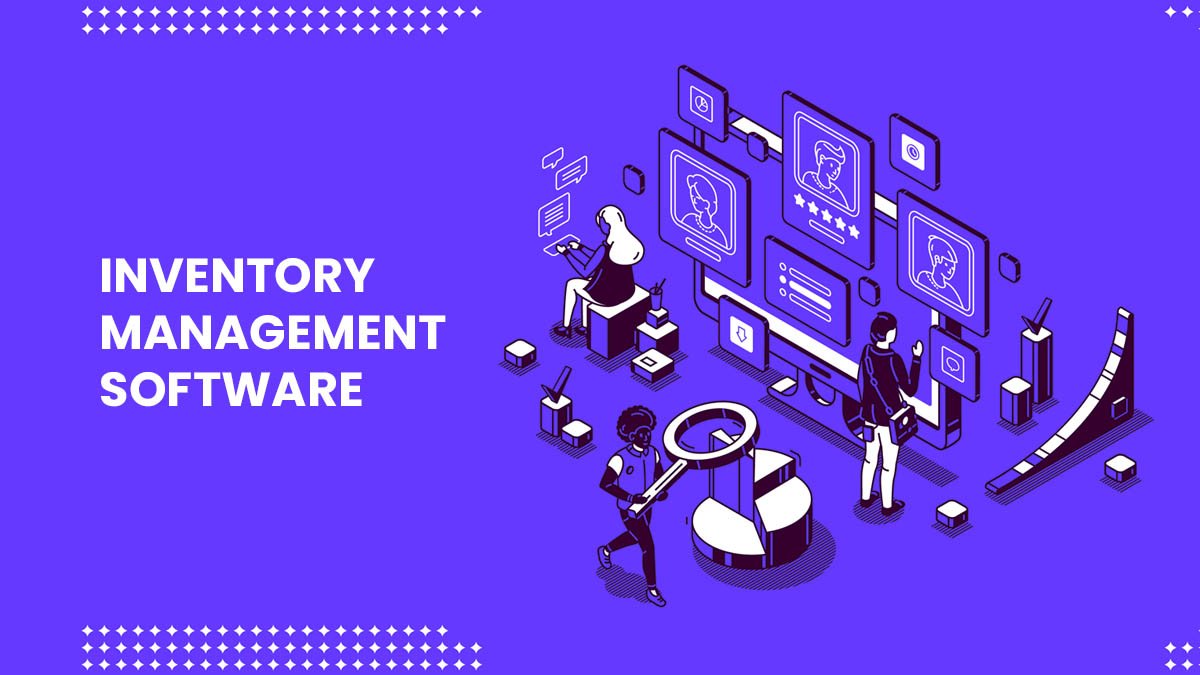
Inventory Management Software
An inventory management system is a must-have, whether you operate a brick and mortar shop, an eCommerce platform, a pharmacy or a logistics business. This will provide you with insights into every aspect of your products, and in some cases will also help you understand your customers better.
An inventory management system is an instrument enabling you to track products through the supply chain of your company. This optimizes the entire continuum from placement of orders with your distributor to order distribution to your customer, mapping a product's entire journey. In other words, an Inventory Management Software is a software program that records rates of inventory, orders, purchases, and deliveries. It may also be used to establish a work order, bill of materials and other production-related documents in the manufacturing sector. Companies use inventory management tools to prevent overstocking and outages of their goods. It is a method for organizing inventory data which was usually stored in hard copy or spreadsheet form before.
The accountability that this platform provides has a big effect on a firm's bottom line. Businesses can reduce waste by accurate monitoring of products, identify patterns and make informed investment decisions.
Characteristics
Inventory management software consists of many main components that work together to create a coherent inventory of the systems used by many organizations. Those characteristics include:
- Relocation point : If inventory crosses a certain level, it is possible to program the inventory management system of an organization to tell managers to reorder the product. This helps companies avoid running out of goods or stockpiling too much money.
- Asset monitoring : When a product is in a warehouse or shop, its barcode and/or other tracking parameters such as serial number, lot number or revision number may be used to track it. Schemes. For Business , Business Encyclopedia, 2nd ed. Inventory management software today also uses barcode, RFID ( Radio Frequency Identification), and/or wireless tracking technologies.
- Services : Companies that are primarily service-oriented rather than product-oriented may use inventory management software to track the cost of the materials that they use to deliver services, such as cleaning supplies. In this way, rates can be added to their services that represent the overall cost of doing them.
- Brand Identity : Bar codes are also the means by which inventory management software inputs data on goods and orders. A barcode reader is used to read barcodes and look up the product information they represent. Also growing in popularity are Radio-frequency identification (RFID) tags and wireless product recognition methods. Modern inventory software programs that use QR codes or NFC tags to identify inventory products and smartphones as scanners. This method provides businesses with the option of monitoring inventories using barcode scanning without having to buy costly scanning hardware.
- (i) Optimisation of inventories : A fully automated system for forecasting demand and optimizing inventories to achieve key inventory optimization metrics such as: (i) Reorder point: number of units that should trigger an order for replenishment
- (ii)Quantity of order : number of units to be reordered, depending on the reorder level, stock on hand and stock on order[citation required]
- (iii) Lead demand: The number of units sold in the lead period
- Collection cover: number of days remaining until a stock if no reorder is made
- (iv) Precision: forecasting expected accuracy
The purpose of IMS
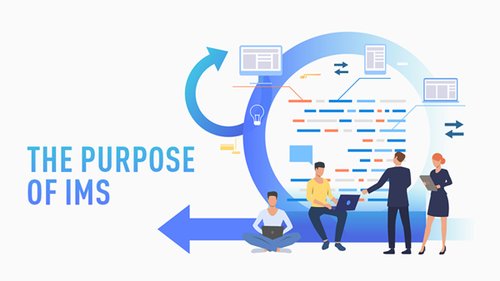
Industries also use inventory tracking software to minimize their carrying costs.The software is used to monitor goods and parts as they are being shipped from a manufacturer to a warehouse, between warehouses, and eventually to a retail location or directly to a customer. Inventory management software is used for a wide variety of applications including:
- Maintaining a balance between stocking too much and too little.
- Tracking of inventories as they are moved between locations.
- Receiving products in a warehouse or some other location.
- Collecting, packaging and dispatching things from a warehouse.
- Keep track of commodity sales and the level of inventories.
- Cutting down on obsolescence and spoilage of goods.
- Avoid losing out on sales due to circumstances outside stock.
- Features of Inventory management software
In addition to any bells and whistles, the program that you select will provide all the features that are necessary for successful inventory management operations. Here's a short rundown of the items to look for:
Barcode scanning: Easily identify and monitor your products; incorporate inventory tracking software for instant product identification and marking with barcode scanners.
Optimization of inventory: Hold the correct amount of inventory for each commodity, without over- or under-stocking any item. This is especially useful if you are working with goods that are undergoing a seasonal rise and fall in demand.
Stock alerts: Receive notices and updates if over- or under-stocking exceeds a given threshold. It will help you position orders or offer exclusive offers to clear out excess stock.
Generation of Report: View sales history as a list of your most famous goods. This feature also helps you to handle items in your inventory that have not met the amount of sales you planned, by providing discounts on them for example.
Managing multi-location: Managing various warehouses and points of sale (POS). The incorporation of all locations into a single inventory management system is feasible.
Handling of stock returns: Manage returns more efficiently by reducing time-to-return and automating the entire operation.
Material grouping: organize inventory into predefined categories and ensure that you are continually updated on the quantities of components and requirements that make up your product stock and handle their reordering schedules as required.
Records of purchase order: Create a single view of records of purchase order. You can quickly determine which goods are in demand, both seasonally and permanently, and be prepared to meet the needs of your customers.
RFID-based in-transit tracking: This feature is useful if the orders are from a third party and the goods are dispatched for delivery. This feature leverages RFID technology to give you real-time monitoring of your in-transit inventory.
Warehouse management: This feature is useful if you need to maximize the warehouse stock and maintain a detailed record of the position of each item. This will give you a single view into where all the goods are kept.
Request forecasting: This feature allows you to rely on past data to predict potential demand. Not all platforms automatically provide it, so if forecasting is relevant for you, be sure to ask the vendors on your shortlist about this capability.
Five must-have inventory automation features
Inventory management automation lets you keep track of products, manage stock rates and accurately evaluate situations. For example , imagine that you got a bulk order for 100 units of one of your best-selling products from one of your frequent customers. You need to make sure you have enough stock before you confirm the order to fulfill it. Your inventory spreadsheet shows you have 102 units on the shelves, but you know that through your physical store, your website, and the online marketplace you entered last year, your company is constantly receiving orders. What if you confirm the order and then hear that another customer earlier today purchased 25 units of this item in your store? To be safe, you will need to check with each of your distribution channels to make sure the stock you need to fulfill this order has not been sold.
Each time an order is delivered through any of your distribution channels, your inventory system will update your stock counts with automation. You do not have to call the shop to check what they sold today, because all sales they made were reflected in the stock system once the products have been removed. So you can expect 102 units to be available for sale if you see you have 102 in stock. There is no danger of overselling, so you can go ahead and confirm the bulk order without having to wait for your client.
How does automation affect your company in Inventory Management?
Whether you are a company owner or manager then you should know that the four key stakeholders in every corporation are the partners or creditors, the staff, the consumers and the suppliers. In your company both of these groups have different interests:
Organizations need to handle a number of things to satisfy the specific needs. But the one specific parameter that can help with all four is operational performance, and this is precisely what automation can help achieve.
By improving precision and speed, Automation helps keep your daily operations efficient. Most inventory applications allow you to set simple workflow rules that cause certain actions without requiring intervention. Through letting automation take on the boring tasks, the staff will focus more on development plans, and you'll have more time to spend on enhancing product quality. This will increase your productivity, making both your clients and investors happy. It will also help you make timely payments which will be valued by your suppliers.
Now that we have an understanding of why you would like to use automation, let's dig deeper and look at the most critical features of automation in any inventory program.
Five must-have automation features
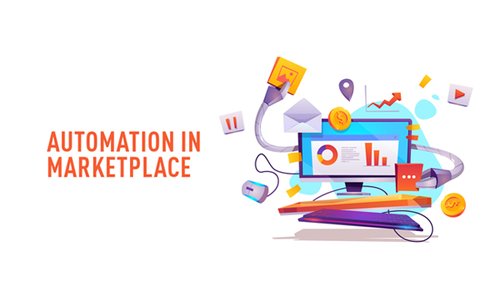
- 1. Automation in marketplace
Order control is a critical field for handling inventories. Order management relates to the everyday process of managing products, handling orders to buy and deliver, invoicing, billing, packing and shipping. Many of those operations can be performed manually in the initial phase of a company. However, the need for automation kicks in when you want to extend your company on-line. For the US eCommerce industry expected to rise to $600 billion by 2024, entering an online marketplace is a wise step. However, along with the extra order volume, a marketplace brings a whole new degree of sophistication to your inventory management. And if you're planning to take your company online, you'll want your program to automatically manage certain marketplace operations: I
i) SKU mapping: Any item you add to your online store or shop will be added to your inventory software automatically and vice versa, depending on the SKU.
ii) Order collection: Any order put online should be automatically pulled and stock status updated in all your online stores and in your inventory software as well.
iii) Real-time shipping rates: Just like orders, make sure your inventory system always monitors real-time shipping rates, so that you can always select the most cost-effective shipping option. - 2. Notification of repurchase order
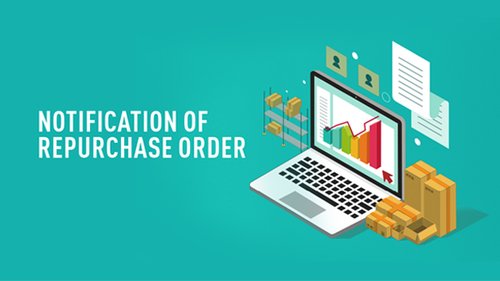
A notice to reorder is like a fire alarm for your company! This feature protects you from one of the biggest challenges any company faces: losing stock. To put it simply, a notification of reordering is an alert device that gets activated when the stock level for an item is dangerously low, thereby reminding you to refill the stock. When the number of products and orders increases, it is difficult to manually track stock rates which can lead to errors. A reorder degree also allows you to pursue a structured approach to purchasing products and stockpiling supplies at the right time in your warehouses. This saves you from overstocking products, which is a major problem many businesses face. A good inventory management system allows you to select the level of reorder for each item (which you can review and adjust as needed), automate the entire process of monitoring your stock and receive updates at the exact point when you need them.
- 3. Barcode Scanning
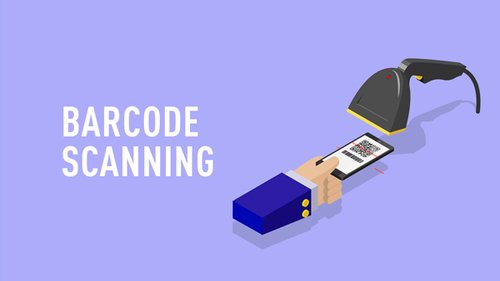
Barcode scanners are electronic devices that scan barcodes of products and record the data in software for inventories. It increases productivity , reduces mistakes and saves time. To give you an example, suppose you receive a bulk order from one of your current customers for three units, each of twenty different products. Once you confirm the order, it will take a considerable amount of manual work and time to complete the description of and unit of each object. You have various SKUs, individual serial or batch numbers, levels, and purchasing costs, and the risk of committing a human error often increases with any additional piece of details.
The job is much simpler with a barcode scanner, and much less prone to error (unless you fail to scan the items). Nonetheless, using a barcode scanner would only be helpful if you have selected the inventory program that allows you to connect a barcode scanner and supports its operations. Do not miss out on this essential automation feature if you have a rising company with a lot of inventory.
- 4. SKU Generators

The barcode scanners make the work much simpler when it comes to managing the SKUs of individual objects. However, if your business maintains a lot of similar item groups with distinguishing attributes, what you need is a tool to manage and not just capture product numbers. For such cases the problem can be solved by a generator of SKU. A SKU generator is a simple tool which suggests a specific SKU based on its attributes for a group of objects. Typically, these tools have three or four fields requesting information about the object, such as the name of the element category, attributes and relevant codes. This also allows you the ability to add more custom fields to the details, so you can drill down.
The following three broad advantages of SKU generator tool:
i) This sets the logic for the SKUs, which in effect reduces ambiguity and repeatability.
ii) It can tailor itself to the business' growing needs. And even if you add more classes or attributes, it's still easy to create an SKU for them
iii) There is hardly any training needed, which means that any member of your warehouse staff can use it efficiently immediately
- Reporting
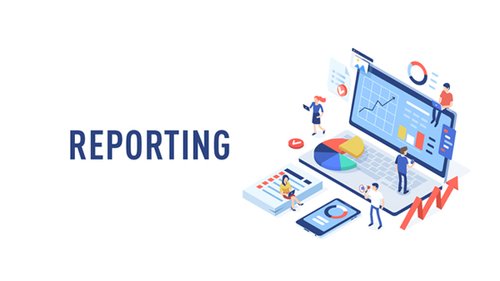
Documents form the basis for decision-making and the development of a plan for any company. To map exact patterns and make a definitive decision, you need the right numbers. Small companies also spend a great deal of time writing these reports, and then brainstorming about them. When the data is manually edited for each transaction in several spreadsheets, this raises the risk of losing out on crucial details or getting a data mismatch. Such delays and errors can be fatal for your company in today's fast-changing markets. An inventory framework simplifies this process for you by continuously updating the data in all the applicable modules. So when you record a sales order in an inventory system you don't need to go back and check the item level status. The program can update the item level and automatically populate your sales reports, report inventory information, and report inventory valuation. This saves time and reduces the possibility of mistakes. A system of inventories that supports reporting and produces the 8 most important reports will prove to be an efficient investment for your company.
For first, the automation can seem a little scary. Business owners may feel discouraged from trying it because they think it needs too much money and is going to be too difficult to manage. But to automate some of your everyday business activities, you don't need a whole ERP Program. A small investment in the right automation tools in cloud-based software can make a big difference for your company. You are off to a good start if your inventory platform manages business activities, reordering, barcodes, SKUs and reports.
Advantages and Disadvantages of Using Inventory Management Software
Any company selling goods needs a robust inventory management system. Computerized inventory control systems make it easier for companies to keep updated regularly with bar codes, point-of - sale applications, and warehouse monitoring. As in any new system implementation, the benefits and drawbacks of using a computerized inventory system should be weighed by business owners before writing a check. Any company that offers products needs to find a good and reliable system of inventory management. A computer-controlled inventory management software makes it easier for companies to keep accurate updates particularly those items with bar codes, warehouse tracking and point-of - sale software. Just like with any new system integration, company owners should consider the advantages and disadvantages of using an inventory system software before writing a check.
The advantages of sophisticated inventory management software that several kinds of retail or wholesale and manufacturing company are utilizing can not be emphasized sufficiently. Using inventory management software facilitates proper management, real-time inventory monitoring, financial integration, comprehensive analytics and timely service delivery to help businesses eradicate and strategically advance the complexity of their operations.
Advantages
- Automated In-Stock and Reorder Data
Computerized inventory keeps workers and consumers aware within seconds whether an item is in stock. Since the inventory is synonymous with sales, there's a running count of what's in stock and not. This increases the needs for flag reordering and offers improved customer support. As inventory drops below a specific threshold, new orders are placed and tracked with vendors to let customers know when the new products will arrive. - Accounts incorporation
Many of the computerized inventory platforms to track cash flow integrate with accounting software. It makes the process of moving product costs and properties seamless between programs and reduces the need for additional costs in bookkeeping. With the shared data between inventory and bookkeeping, financial statements are easier to produce. - Planning and estimating
Product management software does more than monitor the position of the product, and when to reorder it. A data collection program is used to produce appropriate reports for forecasting and strategic planning. Business owners review patterns around which goods perform well in different months or cyclical seasons. Business owners use this data to plan for growth and smartly order inventories to make the best use of cash flow resources. - Preventing shortfalls and delays in production.
Few things are worse than simply running out of parts and supplies when you need them. You should use inventory management tools to prevent unnecessary delays in your production processes and customer order fulfilment. It can help you understand how much inventory you need to keep on hand to meet the demand. - Inventory levels are tracked in real time.
That accompanies the first benefit. Understanding how much inventory you have is beneficial at all times, as it helps you to make good choices about when to reorder items. While purchasing and selling goods, inventory tracking software automatically updates the data, which is much easier than entering the information by hand. - To optimize organization of warehouses.
In order to have good customer service speed is essential. Inventory management software enhances the layout of the warehouse by making the business move faster. You can group together similar products and position popular products in ways that make them easier to access when orders arrive. - Automatically generated reordering of stocks and information on stocks
An automated inventory keeps employees and customers aware of whether an item is in stock or not, in just a matter of seconds. Since the inventory is aligned with real-time transactions, there is a constant count of the items in stock and those that are not. It helps with flagging items which need to be reordered, while providing excellent customer service at the same time. Since inventory falls below a certain level, new product orders are then placed with suppliers or distributors, and periodically monitored to let customers know when new products arrive. - Integration with the accounting with all the appropriate back end systems
Advanced inventory management software makes it easier to synchronize all of the back-end processes that include inventory software, e-commerce systems, and accounting systems. The effect is dramatically reduced data entry requirements, an even simpler order management system, and exact and accurate on-demand financial reports. Integrating the different back end systems with just one inventory management program provides a single framework to handle the inventory-related information. It allows real-time monitoring of cost-effective and reliable order fulfilment across the entire company supply chain. This also makes the entire process of moving inventory expenses and assets through programs straightforward and eliminates the need for additional bookkeeping expenses. Furthermore, financial statements would be easier to access because of the shared data between bookkeeping and inventory. - Improve the marketing decisions and the products.
If company owners do not use inventory management software, as found in many case studies, they are most frequently left in the dark as to which of their items are their biggest players. Using a software designed with the appropriate analytics, one can easily access important data on the performance of a product to help them make informed decisions about their products, such as promotions, advertising campaigns, and keeping stock levels. - Provide details for proper forecasting and planning.
Stock management software does so much more than simply track inventory status and location and when is the best time to reorder the inventory. A data capture program is used to provide pertinent forecast and strategic planning reports. Company owners assess dynamics in particular months or cyclical times over which products are doing well. Business owners use this information to prepare for growth, and smartly plan inventories to ensure the best cash flow capital allocation. - Uses cloud-based tracking of inventories in multiple locations.
Centralized inventory management from various sources is made simpler by the use of cloud-based inventory level management. Shopfronts, warehouses, and e-commerce outlets no matter where they are located all share the same data and processes, essentially unifying the company as one and allowing it to function on all fronts. Regardless of where they are in the world, shop owners and their employees can track orders and execute various business tasks all from a single dashboard. - Break down the chance of human errors.
Business owners rely mostly on people for most processes , particularly when they are just starting up, such as inventory management, ordering, etc. Inaccuracies at stock-level are due to human error, however. And, the cost of these errors would quickly start piling up. Inventory management software streamlines main areas such as removing the need for manual inspections by using barcode scanning, and automatic reordering, which significantly eliminates over- and under-stocking, something that is extremely costly to company.
Disadvantages
- Prone to machine failure
One of the big concerns for any computerized system remains the risk of a system crash. A corrupted hard drive, power failures and other technical problems can result in the loss of the necessary information. Business activities are at the very least hampered, because they can not access the data they need. Enterprise owners must continuously back up data to protect against device failure. - With high potential for malicious hacking
Cyber criminals or hackers are actively searching for new ways to get information about the business or the client. An inventory platform linked to point-of-sale and accounting systems is indeed a valuable resource to be hacked into when searching for the suppliers or consumers' significant financial data or personal information. Nevertheless, updating the security systems and antivirus software can still counteract this potential problem. - It eliminates manual or physical auditing.
Since all is automated, it is easy to forego time-consuming hand inspections of inventories. Once the computers do their work, it might seem that it is no longer necessary. Yet even so, regular manual audits will start identifying losses such as breakage or spoilage. The audits also assist company owners in detecting potential internal fraud and misuse of the computerized inventory system.
More pros and cons

The inventory control program is used to monitor resources and to create docs such as requests for inquiries, work orders, output / input reviews and also material list. For your company there are several benefits to using this type of application. Some drawbacks can also be correlated with inventory management applications, even if they are handled in a very appropriate manner, these drawbacks are a problem. In fact, if you're using one of the better inventory programs on the market, you 're almost definitely not in charge of coping with the cons.
Inventory management program can be a specialized computer based software familiar with tracking various product quantities, orders, sales and deliveries. There is absolutely no limitation about which kind of industry is able to use inventory control software. Suppliers and even manufacturing firms use this program most commonly because it makes it easier to handle various aspects of these procedures. However, there is one particular difference and additional use for which this software system is used by the production company. They use it to build word orders, bills for supplies, and a few other important paperwork and documents related to the production.
Most are working simply because it helps avoid both scarcity along with high stock rates. It can be a modern and groundbreaking method for storing and managing important knowledge about inventories. Additionally, it is much more secure than previous data storage and collection methods like hard copy forms. This system comprises a number of several parts, which collectively work to generate a control program for businesses. In exchange, these control systems are employed to carefully take care of stock and inventories with productivity.
Cost lowering: Many companies are investing huge amounts of money for their inventory. Obviously they won't be able to run their business well enough if they don't try to. Nevertheless, if you use the top inventory program, by not loading the storage room with excessive materials, you will reduce all extra fees. Furthermore, the device software will also help you to avoid missed product sales because you will always have sufficient content, and never have to bring something unnecessary.
High Efficiency: The most efficient products of the inventory system increase your operating performance which leads to greater productivity. Since the program performs many assignments such as collecting information, estimates and preserving information, you could do so. Because the risk of blunders is minimised, efficacy increases. This time you save on your part which you will be using for various other tasks.
Cons
Many inventory management software apps cost incredibly high, and price is undoubtedly a challenge for small and medium-sized companies. The hardware costs could be applied at the expense in relation to bar code viewers along with components. Even so, it might just cost an ounce-cost. You can recover this cost when you are, for the reason that system helps you preserve funds in other ways.
Inventory management software system makes the company activities smoother, is a fairly complicated tool in and of itself. It's also challenging and time-intensive to understand the basic concepts, of course, if you don't have the complete grip, you may not be able to use it well enough. There are plenty of informative guides available to help you interact normally. The company that provides the software for you will also be able to perform workout sessions with your order, but will ask for another amount. So long as you put your energy into this, this barrier can be avoided.
An inventory Software
It keep track of your stock, and watches the Inventory Management System up your stock . Accuracy is necessary when dealing with Inventory Management. You need to know what you've got in stock, how much it's worth and where it's stored to satisfy your customers ' needs and demands. Through Inventory Management Technology, you can guarantee that there are always sufficient amounts of inventories on hand.
Inventory Management Software features:
Set up as many locations as needed for each inventory item. All detail is maintained for each, including quantities and valuation, costs, and prices. Create and maintain lot and serial numbers for those item types. Lot number details include an expiration date and serial numbers include detail purchase and sales information.
Create batches for physical inventory processing based on ABC class, product line or other criteria. Use tag or worksheet entry to enter counts, import counts, and enter counts by exception only. Quantities can be counted in the item base unit or the reporting unit of measure.
Build batches for processing physical inventory based on class ABC, product line, or other criteria. Use the entry tag or worksheet to enter counts, import counts, and input counts by exception. Quantities can be counted in the measurement element base unit or reporting unit.
- Move item amounts as required to various locations; move costs can be entered and applied to the cost of the product being moved.
- Increase or decrease the quantities of items to correct inventory situations as needed. Quantities are automatically changed and changes are preserved to the past.
- Immediately post the received goods as you enter them.
- When stock rates are small, automatically find alternate pieces.
- Physical counts are processed using either worksheets or tags.
- Place groups of objects for the number of cycles
- For physical counts, freeze the amounts as regular processing continues.
- Lots to track.
- Set custom fields for the items in your inventory.
- Using item identifiers, consumer and vendor part numbers, lot numbers, and/or serial numbers to perform fast object lookups.
- Define your own color changes for visual stock level warnings.
- Creating aliases for products in inventory.
- Using exception-only entry in cycles of physical counts.
- Requests to access and process content for internal or work use.Access detailed descriptions for each item as quick as possible.
Top Requirements of Inventory Management Software
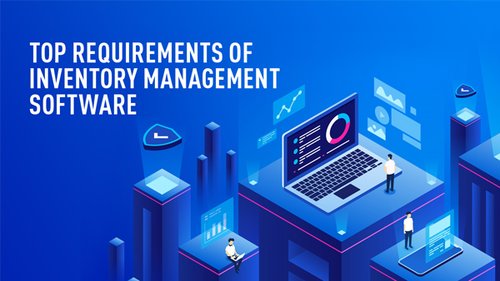
Inventory Management : This module is designed to centralize your basic and most important warehouse functions. Through it, you can see full descriptions of the inventory such as stock rates, product history and other product specifications. All other parts of your system are synchronized with this data, so all of your functions can run using the same information. This is an essential factor in breaking down data silos within your company. Working with the same information ensures a much higher degree of collaboration between your teams than when working with their individual systems.
Inventory Tracking : It's important to monitor your inventory at every move. Many systems enable you to track your inventory by serial numbers, RFID tags, barcodes and other identification numbers. Such devices allow the fast processing of inventory data as it reaches your warehouse first. They also provide an audit of all movement in inventories. This is particularly important for industries dealing in perishables or consumables. If you ever find that you need to remember a particular product, traceability allows you to remember only the affected products. Without traceability, you risk recalling all products, whether affected or not, and losing huge amounts of revenue.
Transfer Management : Companies that manage multiple sites have the advantage of moving their product to the most valuable location. Bundling or kitting your products , especially during certain times of the year, can be attractive to customers. To do this most effectively, you'll want a transfer management equipped system. You can track your inventory as it moves to different sites and facilitate the overall transfer process. To encourage this, some modules provide advanced systems such as pick-to-light and voice picking. Such programs will help guide the workforce and direct it to reduce any uncertainty and streamline their efforts.
Purchasing : Purchasing is an extremely important aspect of any warehouse that relies heavily on seller 's products to manufacture its own. This feature works primarily to help users create and manage buy orders (POs). Many systems include templates that automatically populate data from other parts of the system with existing ones. Users may also find it helpful to directly send email suppliers from their inventory control system, which reduces the time spent switching screens.
Shipping : Good shipping capability is extremely important for overall order fulfillment and level of customer satisfaction. It's good to choose a system that can automate much of the process to reduce any mistakes your customers might experience, such as late deliveries or incorrect packaging. Standard shipping devices usually provide the ability to print labels and barcodes on the package. You may also want a solution that works with top third-party service providers such as UPS and FedEx. But more advanced features of inventory management systems are available, such as the ability to send orders as multiple shipments. This ensures your customers get their in-stock goods quickly with backordered items sent at a later time.
Order Management : Most vendors offer a system of inventory management which can help you manage your sales orders. These tools allow users to tailor the pricing, send quotes, track orders and manage returns. Some advanced systems are synchronizing orders with stock levels, marking items for shipping, supporting multichannel sales and making self-adjustments to maintain profitability. Increasing and sustaining customer loyalty is an important aspect of order management.
Reporting and Analytics : Analytics and reporting are excellent tools to be able to grow your business as you plan to. Analytics tools assess patterns in your processes in order to predict future demand and sales. Predicting demand is a way to reduce defense stocks and bear costs. It is no longer important to carry inventory around merely for the sake of protection when you have clear insights into how much you would really need.
Perhaps by now, you can understand better the functionality of the inventory management system and what the company needs. You'll need to find the best inventory management software for your company once you've decided what your requirements are.
Lets start with the simple way to create a website.

Interested in Domitos? Get the Features Guide Today!
Domitos, is world's most sought after facility Management System and we look forward to work with. Digitize your facilities today!